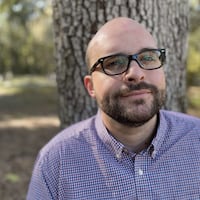SPRING BLUFF — The gravedigger’s old pickup grumbled and creaked as its winch lifted the casket from the hard South Georgia dirt. Exhaust spewed from the tailpipe, floating off through the graveyard shaded by ancient oaks, draped in Spanish moss. GBI agents waited silently, hoping the casket contained evidence to help solve a 35-year-old double murder.
Harold and Thelma Swain were gunned down in their church, the small white building on the side of the cemetery, during a Bible study on March 11, 1985. A visitor had asked to speak with Harold Swain, 66, a deacon and retired pulpwooder, and then shot him in the chest during a struggle. Thelma Swain, 63, a homemaker who loved softball and cracking jokes, took a bullet to the chest when she ran to help her husband.
Since that night, the question of who killed them has haunted this rural Camden County community of piney woods. Now the GBI hopes Harold Swain might’ve held the key to solving the case all along, if the killer’s DNA ended up on his body.
Agents exhumed the body Wednesday morning to search for DNA on the remains, such as under the fingernails. If Harold Swain scratched the killer in the fight, the DNA could still be there.
In 2003, Dennis Perry, a construction worker who had lived in the area, was found guilty of the murders, but his conviction was overturned this summer after a DNA test linked a previous suspect to the crime scene. Perry is waiting for the local district attorney to decide whether to put him on trial again, though experts say that would be unfair because of the mounting evidence against the other suspect. The test was conducted by Perry’s defense team at The Georgia Innocence Project, along with King & Spalding, after reporting by The Atlanta Journal-Constitution showed that the alibi of a previous suspect appeared to be fraudulent.
GBI has given no indication that Perry is actively under investigation.
But the agency has indicated it is investigating Erik Sparre. It was the evidence against Sparre that sparked the renewed investigation. He was briefly a suspect in 1986 after, police records say, he was caught on tape bragging about killing the couple, and using a racial slur to describe the Swains. The Swains were Black; Sparre, like the killer, was white.
In March, the DNA test showed that Sparre couldn’t be excluded as the contributor of hairs found stuck in the hinge of a pair of glasses left next to the bodies. Since then multiple people have testified he made statements to them about killing the couple. Sparre has denied involvement in the murders.
The DNA match means that someone in Sparre’s maternal line contributed the hairs. More precise results aren’t possible because the hairs have gone missing since they were tested in 2001. GBI scientists believe new technology could be used to test a sample from the body and determine the individual who shot the couple.
“Technology has changed and developed,” said Stacy Carson, the special agent in charge at the GBI’s Kingsland office. “So we’re taking the opportunity to gather what we need.”
Credit: Tyson Horne / tyson.horne@ajc.com
Credit: Tyson Horne / tyson.horne@ajc.com
Several DNA experts told The AJC the GBI could be successful, if the remains were well-preserved in a good vault and casket.
“It’s possible,” said John Butler, a DNA expert at the National Institute of Standards and Technology. “There’s been DNA obtained from mummies from thousands of years ago.”
DNA testing wasn’t done in the 1980s because the science was in its infancy.
When the gravediggers brushed away the dirt, they found a heavy cement vault entombing a casket that appeared only somewhat weathered by years. It was a yellow, musty color with dulled silver adornments on the corners. Workers pried it open with a crowbar.
A GBI crime lab employee wearing a face shield and blue rubber gloves knelt before the casket. Agents from the special task force investigating the murders stood quietly watching as the woman assessed the remains. Slowly she began removing small items, possibly fingernails. She wrapped them in paper towels and passed them to an agent who secured them in tiny manila envelopes.
Credit: WJXT TV
Credit: WJXT TV
Agents declined to go into detail about what they took, but they said the material would be tested for DNA. Generally, the crime lab faces a backlog of cases, pushing wait times out as far as several months. But agents weren’t yet sure if the testing in this case could take that long.
Joe Gregory, the GBI’s original lead investigator on the case, was hopeful after hearing of the task force’s idea to check for DNA on Harold Swain. Gregory, along with the Camden County Sheriff’s Office’s lead on the case, former Chief Deputy Butch Kennedy, have long been advocates of Perry, who they always believed was innocent. It was another investigator who built the case against Perry after Gregory and Kennedy had left law enforcement.
'That’s wonderful," Gregory said on the phone Wednesday. “I hope the world they do get some DNA."
Once the agents concluded their search, the gravediggers shut the casket lid with a pop. The winch lowered it back in the ground. The men covered it with dirt, hopefully for the last time.
Credit: Tyson Horne
Credit: Tyson Horne
OUR REPORTING
After AJC reporting found issues with the alibi of a previous suspect, lawyers representing Dennis Perry, the man convicted of the double murder, decided to conduct a DNA test. DNA found on at the scene matched the old suspect, the lawyers said. The GBI has reopened the murder investigation and formed a task force. On July 17, the DNA results led a judge to overturn Perry’s conviction. Perry was released on bond on July 23.
About the Author
The Latest
Featured




